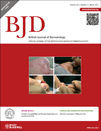Vitamin D deficiency and rickets in children and adolescents with ichthyosiform erythroderma in type IV and V skin
Funding sources Indian Council of Medical Research.
Conflicts of interest None declared.
Summary
Background Ichthyosiform erythroderma due to keratinizing disorders may suppress cutaneous vitamin D synthesis, leading to vitamin D deficiency and rickets.
Objectives To determine the prevalence of vitamin D deficiency and rickets in children and adolescents with congenital ichthyosis and other keratinizing disorders with erythroderma and scaling.
Patients and methods In this cross-sectional study, 45 children and adolescents with ichthyosiform erythroderma due to keratinizing disorders, and 66 controls (group 1: age and sex matched, with skin diseases other than keratinizing disorders; group 2: age and sex matched, healthy volunteers) were included. Evidence of rickets was determined clinically (physical examination and radiographs) and biochemically {serum calcium, phosphorus, alkaline phosphatase, 25-hydroxy vitamin D [25(OH)D] and parathyroid hormone (PTH)}.
Results All patients in the disease group had clinical, radiological or biochemical evidence of rickets [25(OH)D < 20 ng mL−1], and analysis was done for all subjects with the available biochemical reports. The mean serum 25(OH)D levels of the disease group was 8·38 ± 5·23 ng mL−1 and was significantly lower than in control group 1 (11·1 ± 5·8 ng mL−1) (P < 0·01) and control group 2 (13·5 ± 6·9 ng mL−1) (P < 0·001). The prevalence of vitamin D deficiency [25(OH)D < 20 ng mL−1] was significantly higher in the disease group (n = 38 of 39, 97·4%) than in control group 2 (n = 12, 70·6%) (P < 0·01), and total controls (n = 56, 84·8%) (P = 0·04). The frequency of hyperparathyroidism (PTH > 65 pg mL−1) was also significantly higher in the disease group than in controls (P < 0·01).
Conclusions Children and adolescents with various forms of ichthyosiform erythroderma, especially those with pigmented skin (types IV–VI), are at increased risk of developing vitamin D deficiency and clinical rickets.




